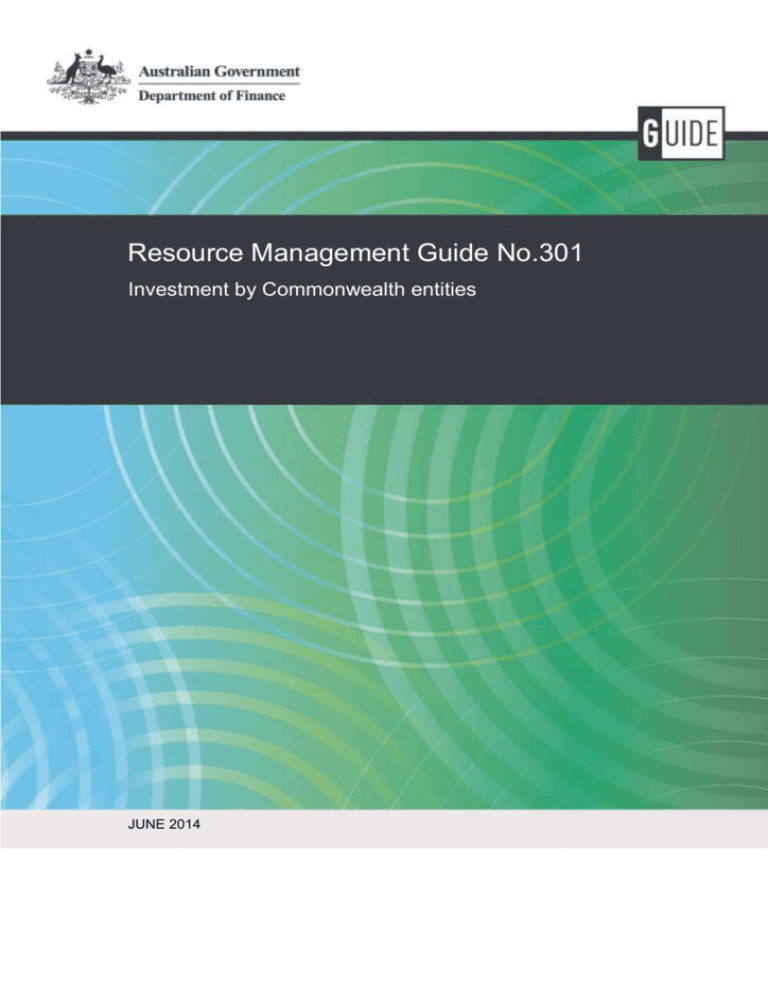Resource Management Guide No.301
advertisement

Resource Management Guide No.301 Investment by Commonwealth entities JUNE 2014 © Commonwealth of Australia 2014 ISBN: 978-1-922096-37-1 (Online) With the exception of the Commonwealth Coat of Arms and where otherwise noted, all material presented in this document is provided under a Creative Commons Attribution 3.0 Australia (http://creativecommons.org/licenses/by/3.0/au) licence. The details of the relevant licence conditions are available on the Creative Commons website (accessible using the links provided) as is the full legal code for the CC BY 3 AU licence. Use of the Coat of Arms The terms under which the Coat of Arms can be used are detailed on the following website: www.itsanhonour.gov.au/coat-arms. Contact us Questions or comments about this guide should be directed to: Public Management Reform Agenda Implementation Branch Department of Finance John Gorton Building King Edward Terrace Parkes ACT 2600 Email: governancepolicy@finance.gov.au Internet: www.finance.gov.au This guide contains material that has been prepared to assist Commonwealth entities and companies to apply the principles and requirements of the Public Governance, Performance and Accountability Act 2013 and associated rules, and any applicable policies. In this guide the: mandatory principles or requirements are set out as things entities and officials ‘must’ do; and actions, or practices, that entities and officials could do to give effect to those principles and/or requirements are set out as things entities and officials ‘should consider’ doing. Audience This guide is relevant to accountable authorities of: non-corporate Commonwealth entities who are delegated investment power from the Finance Minister or Treasurer under section 58 of the Public Governance, Performance and Accountability Act 2013 (PGPA Act) and section 22 of the Public Governance, Performance and Accountability Rule 2014 (PGPA Rule); and corporate Commonwealth entities under section 59 of the PGPA Act. Key points This guide: describes investment management and reporting processes to assist Commonwealth entities1 with the effective management and reporting of investment activities details the scope of investment powers of Commonwealth entities, including the extent to which the Finance Minister and Treasurer may delegate these powers to non-corporate Commonwealth entities, and the power provided to corporate Commonwealth entities comes into effect on 1 July 2014, when the PGPA Act and PGPA Rule also take effect. Resources This guide is available on the Department of Finance website at www.finance.gov.au as are the other resources listed below: For guidance on the investment reporting requirements of Commonwealth entities, refer to the Financial Reporting Rules 2014 For guidance on Commonwealth banking, refer to the Agency Banking Framework Guidance Manual foreign exchange risk management guidelines. Investment by non-corporate Commonwealth entities 1. This guide supports the investment provisions in section 58 of the PGPA Act by detailing the forms of investments that the Finance Minister and the Treasurer are authorised to make on behalf of the Commonwealth. 2. The power to invest relevant money in accordance with section 58 of the PGPA Act can only be obtained through a delegation from the Finance Minister or Treasurer.2 Section 58 also places requirements on how investments are to be administered and sets limits on the types of investments that can be made. 3. Delegations by the Finance Minister can be provided to individual accountable authorities in relation to specific moneys (usually moneys standing to the credit of special accounts that have a clear business need for investment). 1 Commonwealth entities and the two types of Commonwealth entities are defined in sections 10 and 11 of the PGPA Act. 2 Sections 107 and 108 of the PGPA Act allow for the Finance Minister and the Treasurer to delegate certain powers. Resource Management Guide 301 Investment by Commonwealth entities | 1 4. The Treasurer has delegated investment powers to the Australian Office of Financial Management for its role in managing the Commonwealth’s public debt. 5. A small number of non-corporate Commonwealth entities have enabling legislation permitting investment activities. The provisions in section 58 of the PGPA Act do not limit the investment provisions in an entity’s enabling legislation. Authorised investments 6. 7. If an accountable authority is delegated investment powers by the Finance Minister or the Treasurer, that accountable authority can only invest in the following authorised investments: securities of, or securities guaranteed by, the Commonwealth, a state or a territory a deposit with a bank,3 including a deposit evidenced by a certificate of deposit; or any other form of investment prescribed by the rules. In addition, the Treasurer may also delegate to particular accountable authorities the power to invest in debt instruments with an investment grade credit rating that: are issued or guaranteed by the government of a foreign country are issued or guaranteed by a financial institution whose members consist of foreign countries (which may also include Australia); or are denominated in Australian currency. Investment rule for non-corporate Commonwealth entities 8. Section 22 of the PGPA Rule prescribes additional kinds of investments that the Finance Minister, the Treasurer and their delegates are authorised to make. 9. The investments authorised by the rule for non-corporate Commonwealth entities are: a bill of exchange accepted or endorsed only by a bank a professionally managed money market trust (if the Finance Minister or Treasurer is satisfied of certain conditions) a debt obligation registered on the Austraclear system (a dematerialised security).4 Investment by corporate Commonwealth entities 10. This guide supports the investment provisions in section 59 of the PGPA Act by detailing the forms of investments that the accountable authorities of corporate Commonwealth entities have the power to invest in. 11. Accountable authorities can only invest money that is ‘not immediately required for the purposes of the entity’. 3 The term ‘bank’ is defined in section 8 of the PGPA Act. The following investments are outside the scope of investments described as ‘a deposit with a bank’: medium-term notes and fixed or floating rate notes, money market trusts or cash management trusts, and bills of exchange that do not comply with the rules. 4 Information about the Austraclear system can be found on the Australian Securities Exchange’s website at www.asx.com.au/services/settlement/austraclear.htm. Resource Management Guide 301 Investment by Commonwealth entities | 2 12. The money can only be invested: on deposit with a bank, including a deposit evidenced by a certificate of deposit in securities of, or securities guaranteed by, the Commonwealth, a state or a territory in any other manner approved by the Finance Minister in writing; or for a government business enterprise—in any other manner that is consistent with sound commercial practice. 13. A small number of corporate Commonwealth entities have enabling legislation permitting investment activities. The provisions in section 59 of the PGPA Act do not limit the investment provisions in an entity’s enabling legislation. 14. A spending limit provision in a corporate Commonwealth entity’s enabling legislation does not apply to a contract for investment of money under section 59, unless the provision expressly states that it applies to such a contract. 15. A spending limit provision in a corporate Commonwealth entity’s enabling legislation generally prevents the entity from entering into a contract involving the expenditure or payment above a specified amount without the approval of a specified person. 16. Commonwealth corporate entities that have a business need to broaden their investment powers under section 59 should consult the Department of Finance before formally seeking approval from the Finance Minister.5 Investment management and reporting for Commonwealth entities 17. An accountable authority who has been delegated the power to invest by the Finance Minister or the Treasurer should ensure that their entity develops an investment management plan6 that will enable the accountable authority (or their delegate7) to effectively monitor and manage the investments held by the entity. While the structure of the plan will be dependent on the amount invested and the complexity of the investment structure, a Commonwealth entity should consider the following as a foundation to its investment plan: access to an adequately skilled internal treasury expert or investment adviser risk analysis and management return analysis a documented investment strategy. 18. While there is no formal requirement for Commonwealth entities to provide detailed performance reporting information through external reporting processes (such as annual reports), monitoring of investment performance provides a useful management tool to support decision-making about the treatment of current investments and the focus of future 5 A list of current investment approvals by the Finance Minister for corporate Commonwealth entities under section 59(1)(iii) is available at www.comlaw.gov.au/Details/F2008L02067/Download. 6 A specific document called an investment management plan is not required, but accountable authorities should ensure that the entity maintains sufficient documentation to adequately monitor and manage its investments. 7 Section 110 of the PGPA Act allows accountable authorities to sub-delegate the investment powers provided to them by the Finance Minister or the Treasurer. Resource Management Guide 301 Investment by Commonwealth entities | 3 investment. Performance information may include a combination of qualitative and quantitative data. 19. The Financial Reporting Rules 2014 include the reporting requirements and guidance for Commonwealth entities that have the power to invest under the PGPA Act. Resource Management Guide 301 Investment by Commonwealth entities | 4









